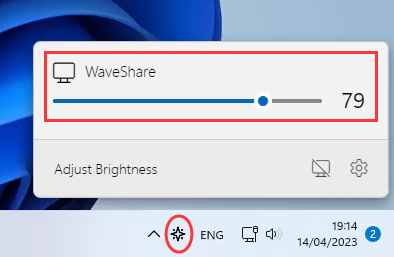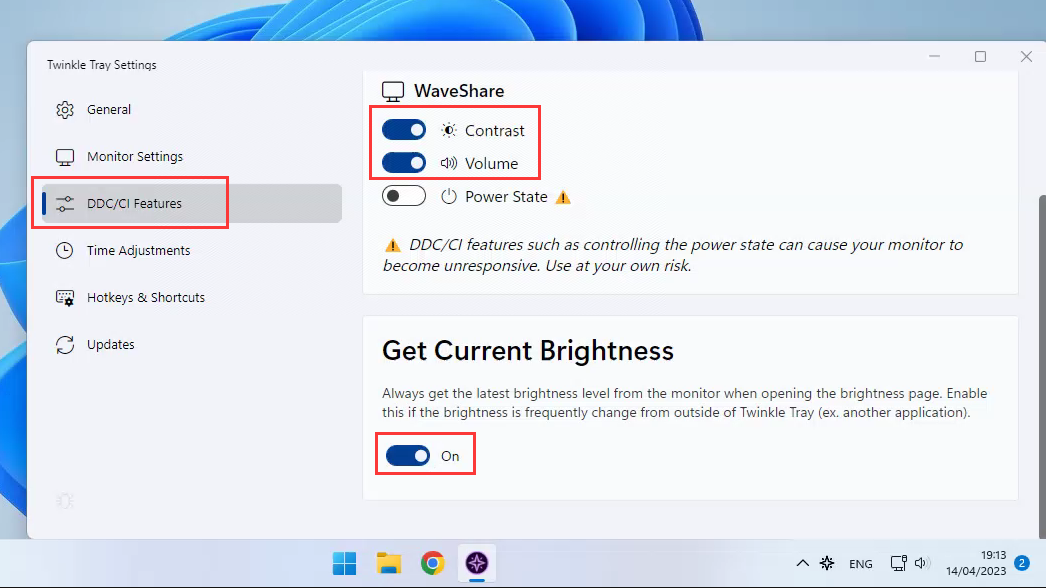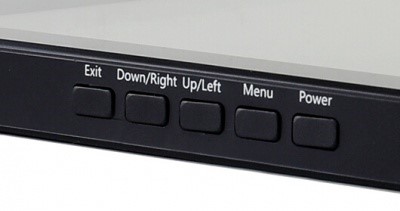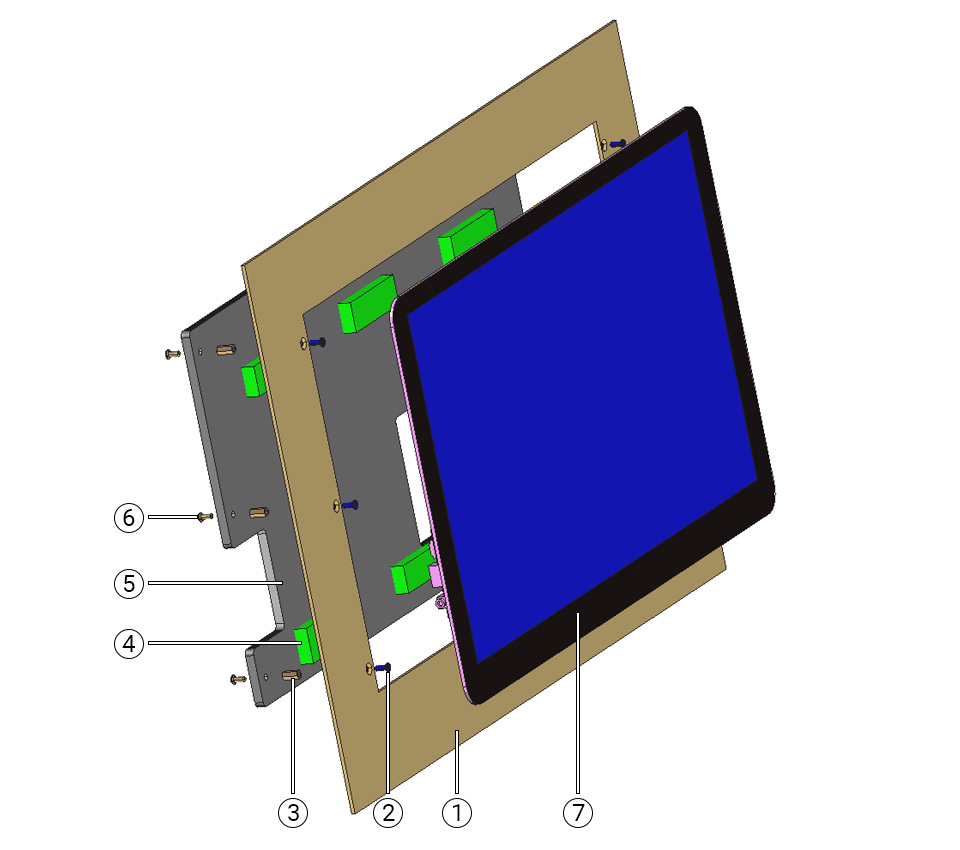15.6inch HDMI LCD (H) (with case)
| ||
Overview
Introduction
15.6inch IPS screen, 1920 x 1080 high rsolution.Toughened class cover. Supports Multi mini-PCs, multi systems.
| more |
Features
- 15.6inch IPS screen, 1920 x 1080 high resolution.
- Toughened glass capacitive touch panel, 6H hardness, 10-point capacitive touch control.
- When used with Raspberry Pi, supports Raspberry Pi OS / Ubuntu / Kali and Retropie.
- When used as a computer monitor, supports Windows 11/10/8.1/8/7.
- Multi-language OSD menu, for power management, brightness/contrast adjustment, etc.
- 3.5mm audio jack, supports HDMI audio output.
Working with PC
This product supports Windows 11/10/8.1/8/7 OS.
1. Connect the 12/1A power adapter to the DC interface of the LCD, after connecting the backlight will light.
2. Connect the TOUCH interface of the LCD to the USB interface of the PC. Waiting for a moment, The touch will be recognized by Windows automatically.
3. If you use the HDMI interface, you need to connect the HDMI interface of the LCD to the HDMI port of the PC. After 5s later, you can see that the LCD display properly. If you need the audio, you can insert 3.5mm earphones into HP ports.
4. If you want to use a VGA interface, you need to connect the VGA interface of the LCD to PC's VGA ports by Mini HDMI to VGA Cable.
【Note】
1) If multi-screen are connected to one PC at the same time, you can only control the cursor by this LCD, so please set the LCD as the main screen.
2) Some of PC cannot support the HDMI screen Hot Plug. In this case, you can try to reboot the system to make the LCD display normal.
3) HP audio output only works while using HDMI communication.
4) Mini HDMI to VGA Cable is necessary and needs to be purchased separately if you use VGA communication.
Windows Software Dimming
- 1. Download and install DDC/CI application, for example, the open-source Twinkle Tray.
- 2. Open the software dimming icon, it will recognize the Waveshare monitor and adjust the monitor backlight brightness by sliding the scroll bar.
- 3. You can also enter the DDC/CI application settings interface to enable contrast adjustment, volume adjustment, and other functions.
Working with Raspberry Pi
This model can support Raspberry Pi OS / Ubuntu / Kali and Retropie systems. When working with Raspberry Pi, the resolution must be set manually, otherwise, it will cause an abnormal display. For more detailed information, please read the following section.
1. Download the Raspbian image from Raspberry Pi website.
2. Connect the TF card to your PC and format it by SDFormatter software.
3. Write the .img file to your TF card by Win32DiskImager software. Select the system image downloaded in Step 1, and click 'Write' to write the system image.
4. After the image has finished writing, open the config.txt file in the root directory of the TF card, add the following code at the end of config.txt, then save and quit the TF card safely.
hdmi_group=2 hdmi_mode=82 hdmi_cvt 1920 1080 60 6 0 0 0
You must make sure that there are no spaces on either side of the equal sign.
5. Connect the Touch interface of the LCD to the USB port of Raspberry Pi.
6. Connect the HDMI interface of the LCD to the HDMI port of Raspberry Pi.
7. Save and connect the TF card to your Pi then power up.
Linux Software Dimming
- Using the DDC/CI demo, here we take the ddcutil tool as the example:
#Install ddcutil tool: sudo apt-get install ddcutil -y #Detect whether it supports DDC/CI monitors: sudo ddcutil detect #Adjust the monitor brightness, <value> needs to modified as 0-100. sudo ddcutil setvcp 10 <value>
For more ddcutil function commands, you can refer to http://www.ddcutil.com/commands/.
Working with Horizon Sunrise X3 Pi
Support Ubuntu20.04 system.
Please download the ubuntu20.04 image from here, and then program the system according to the user manual.
- How to use:
- 1) Connect the 12V power supply to the DC port of the LCD, and you can see the LCD backlight is on.
- 2) Connect the USB interface of the X3 Pi to the touch interface of the LCD.
- 3) Connect the HDMI interface of the X3 Pi to the HDMI interface of the LCD.
- 4) Connect the 5V power supply to the X3 Pi and power on it.
Note:
- If you connect the LCD after booting X3 Pi, and there is no image on the LCD, you need to reboot the X3 Pi.
Keys Description
Only the 15.6-inch HDMI LCD (H) (with case) has the OSD Menu and the related control buttons.
- Power: Turn on/off LCD. If you do not need to use the LCD for a long time, you can use this button to turn off the backlight and reduce power consumption.
- Menu: Open OSD Menu/OK. Press the key to open the OSD menu. When using the menu, it can also be used as a confirmation button.
- Up/Left: Direction buttons.
- Down/Right: Direction buttons.
- Exit: Return.
Screen installation reference instructions
The bonding method between the LCD of the screen and the touchpad is using double-sided adhesive. In order to prevent the LCD and the touchpad from peeling off in some special situations (such as when the screen is installed at an angle), it is necessary to make structural support for the LCD when installation. A reference example you can check below.
【Note】 The assembly materials used below are not included in the shipped kit! ! This is only used as a reference for installation and materials.
Reference Drawing
Part Name:
1. Equipment case
2. Countersunk head machine screw
3. Copper pillar
4. Adhesive sponge
5. Acrylic board (thickness 5mm and above)v
6. Round head machine screw
7. HDMI LCD
Assembly instructions
1. Fix the Copper pillar ③ on the back of the Equipment case ① with countersunk screws ②, and then embed HDMI LCD ⑦ into the Equipment case ① and bond it firmly. The countersunk screw holes on the casing will be blocked by the edge of the screen. So the screws cannot be seen on the exterior side.
2. Paste the Adhesive sponge ④ with an appropriate thickness on the Acrylic board ⑤, pay attention to the position of the paste to avoid the PCB board, and finally fix it on the copper pillar ③ with the Round head machine screw ⑥. After assembly, make sure that the sponge is fully attached to the back of the LCD.
3. The opening holes on the acrylic board avoid the components on the PCB board to facilitate the connection between the interface and the device.
Note: The LCD display surface cannot be installed parallel to the ground, otherwise it will fall off under the action of gravity. In addition, when it needs to be installed at an angle, the back of the LCD screen should be kept at least less than 75 degrees from the horizontal.
3D drawing of assembly effect
Resources
- Dimesnion of 15.6inch HDMI LCD (H) (with case)
- putty
- Panasonic_SDFormatter-SD card formatting software
- Win32DiskImager-Burn image software
FAQ
Add the following command to /boot/config.txt:
disable_splash=1
{{{5}}}
Replace the custom image with the image in this directory /usr/share/plymouth/themes/pix/splash.png.
{{{5}}}
Raspberry Pi Long-press Right-click Software Installation
Test environment: 2022-04-04-raspios-bullseye-armhf 32-bit system.
Models supported: Supports Waveshare DSI LCD, DPI LCD, and HDMI LCD capacitive touch screen series 32-bit systems, while 64-bit systems are not supported by default
wget https://files.waveshare.com/upload/1/18/Evdev-right-click-emulation.zip unzip Evdev-right-click-emulation.zip cd evdev-right-click-emulation sudo apt install build-essential libevdev2 libevdev-dev -y sudo cp 'out/evdev-rce' '/usr/local/bin/' sudo chmod +x '/usr/local/bin/evdev-rce'
Enter the command:
sudo evdev-rce
After running, you can touch and long press to realize the right-click function.
Set up Pi User to Run
sudo usermod -G 'input' -a pi echo 'uinput' | sudo tee -a /etc/modules sudo nano /etc/udev/rules.d/99-uinput.rules
Add following in 99-uinput.rules file.
KERNEL=="uinput", MODE="0660", GROUP="input"
Save it and run it in the terminal.
sudo udevadm control --reload-rules sudo udevadm trigger
Then reboot:
sudo reboot
Run after reboot (no sudo needed at this point).
evdev-rce
After running, you can touch and long press to realize the right-click function.
Set Startup
Enter in the terminal.
sudo mkdir ~/.config/autostart sudo nano ~/.config/autostart/right_click.desktop
Add the following in right_click.desktop.
[Desktop Entry] Version=1.0 Type=Application Name=evdev-rce GenericName=Enable long-press-to-right-click gesture Exec=env LONG_CLICK_INTERVAL=1000 LONG_CLICK_FUZZ=200 /usr/local/bin/evdev-rce Terminal=true StartupNotify=false
If you want to modify the sensitivity, you can modify the two parameters: LONG_CLICK_INTERVAL=1000, LONG_CLICK_FUZZ=200.
It depends on the system, if the system has hibernation, the screen will also be black. If it is the official system of Raspberry Pi, the default is about ten minutes without action to have hibernation.
The other is the TOUCH interface, which generally needs to be connected to the USB interface of the host. Power is drawn through the USB interface. The working current is about 5V 80mA.
12V 1A outer diameter 3.5 and inner diameter 1.35. If you want to use other power supplies, you need to ensure that the power supply ripple is within ±5%
You can use a 10-15V power supply and it will work fine.
Also please note: This screen supports a maximum voltage of 16V, if it exceeds 16V, it may burn out the power supply IC.
{{{5}}}
Support
Technical Support
If you need technical support or have any feedback/review, please click the Submit Now button to submit a ticket, Our support team will check and reply to you within 1 to 2 working days. Please be patient as we make every effort to help you to resolve the issue.
Working Time: 9 AM - 6 PM GMT+8 (Monday to Friday)




